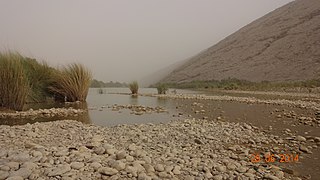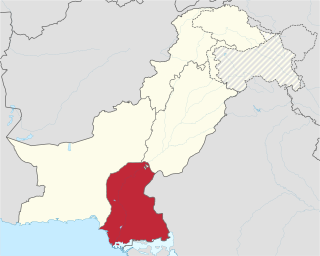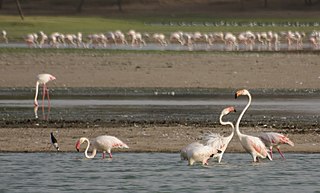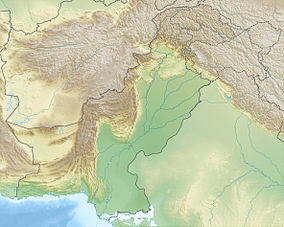
Hub River is located in Hub District, Balochistan, Pakistan. It starts from the Pab Range in the south eastern Balochistan and continues along the border of Sindh and reaches Hub and then falls into the Arabian Sea. "Hab river emerges from mountains near Zahri village of Jhalawan, and it flows along the border of Sindh and Lasbela for 60 miles and it ends at Arabian Sea near Ras Monzi. Greek historians named it as Aarabes, its eastern side was called Arabti and the area of western side of its bank as Orieti. After the month of September the water level of the river remains up to 8 inches. Its banks are at considerable height covered by greenery. Rainy branches Sarona, Samutri and Veera carry rainy water into it. The fish of Hub are tasty". The total length of hub river is 134 km

Hub Dam is a reservoir on the Hub River. It is situated 56 km from Karachi city in Karachi and Hub District on Sindh and Balochistan provinces border. The dam is extended to 24300 acres with gross storage capacity of 857000 acre feet. It is Pakistan's fifth-largest dam. It is an important source that provides the drinking water to the metropolitan city Karachi.

Keenjhar Lake commonly called Malik Lake is located in Thatta District of Sindh the province of Pakistan. It is situated about 36 kilometres (22 mi) from the city of Thatta. It is the largest fresh water lake in Pakistan and an important source of drinking water for Thatta District and Karachi city. Through the construction of a bund on the eastern side, it is said that the lake was formed by the union of two lakes: Sonehri and Keenjhar.
Hadero Lake is located in Thatta District, Sindh. It is an important brackish wetland, where waterfowl occur. It was declared wildlife sanctuary for the protection of migratory and resident birds.
Nara Desert Wildlife Sanctuary is located in Mirpurkhas District, Sindh, Pakistan.
The Rann of Kutch Wildlife Sanctuary is the largest Ramsar site in Sindh, covering 566,375 ha, and is located in the Rann of Kutch in Badin District, Sindh, Pakistan. It was declared a wildlife sanctuary by the government of Sindh in 1980.

Koyna Wildlife Sanctuary is a wildlife sanctuary and natural World Heritage Site, which is located in Satara district of the Indian state of Maharashtra. Further, this wildlife sanctuary is designated as an Important Bird area. The sanctuary is nested in the Western Ghats, covering an area of around 423.55 km2 (163.53 sq mi), and elevations ranging from 600 to 1,100 m. It was notified in 1985 as a wildlife sanctuary situated in Maharashtra. It forms the northern portion of the Sahyadri Tiger Reserve, with Chandoli National Park forming the southern part of the reserve.

The wildlife of Pakistan comprises a diverse flora and fauna in a wide range of habitats from sea level to high elevation areas in the mountains, including 195 mammal, 668 bird species and more than 5000 species of Invertebrates. This diverse composition of the country's fauna is associated with its location in the transitional zone between two major zoogeographical regions, the Palearctic, and the Oriental. The northern regions of Pakistan, which include Khyber Pakhtunkhwa and Gilgit Baltistan include portions of two biodiversity hotspot, Mountains of Central Asia and Himalayas.

Pakistan's native fauna reflect its varied climatic zones. The northern Pakistan, which includes Khyber Pakhtunkhwa and Gilgit Baltistan, has portions of two biodiversity hotspots, Mountains of Central Asia and Himalayas.

The fauna of Sindh live in an area with a semi arid climate. With its coastal and riverine forests, its huge fresh water lakes, mountains and deserts, Sindh supports a large and varied wildlife population.

Shendurney Wildlife Sanctuary is a protected area in the Western Ghats, India, located in Kollam district of Kerala and comes under the control of the Agasthyamalai Biosphere Reserve. It was established on 25 August 1984 and comprises 172.403 square kilometres (66.565 sq mi). The name is a corruption of the Chengurinji, a tree endemic to the region. The sanctuary has an artificial lake of nearly 18.69Sq.km size and also surrounded by the reservoir of Thenmala Dam. The Shendurney Wildlife Sanctuary is a treasure house of plant diversity. About 1257 species of flowering plants belonging to more than 150 families are reported from this sanctuary of which 309 species are endemic to Western Ghats. Birds from 267 species including migratory, endemic and endangered species have been reported here.

Hingol National Park or Hungol National Park is one of the largest national parks in Pakistan, located in the Makran coastal region. The park covers an area of about 6,100 square kilometres (2,400 sq mi) and is located 190 km from Karachi in the three districts of Gwadar, Lasbela and Awaran in Balochistan. Hingol was declared a national park in 1988.
Kaimur Wildlife Sanctuary is situated in Kaimur District and Rohtas District of Bihar. It is the largest sanctuary in the state and extended in area of 1,504.96 km2 (581.07 sq mi) in plateaued landscape of Kaimur Range. It was established in 1979. The major forest types are Tropical Dry Mixed Deciduous, Dry Sal Forests, Boswellia Forests and Dry Bamboo Brakes. It is home to rare and endangered flora and fauna. Rohtasgarh Fort and Shergarh Fort are also located in these forests. It also have numerous Megaliths, Rock painting of prehistoric age and stone inscription from a bygone era. The Government of Bihar has planned to developed it into Tiger Reserve

Thol Lake is an artificial lake near Thol village in Kadi in Mehsana District in the Indian state of Gujarat. It was constructed as an irrigation tank in 1912. It is a fresh water lake surrounded by marshes. It was declared the Thol Bird Sanctuary in 1988; it is a habitat to 150 species of birds, about 60% are waterbirds. Many migratory birds nest and breed in the lake and its periphery. The two most prominent species of birds recorded in the sanctuary are flamingoes and sarus crane. The sanctuary is also proposed to be declared an Eco-Sensitive Zone, conforming to the Environment (Protection) Act, 1986, for which draft notification has been prepared.

Damda reservoir in Sohna, near Gurugram city in Gurugram district in the Indian state of Haryana. Damdama Lake is a small lake in Haryana and was formed when a stone and earthen dam constructed by the British was commissioned for rain water harvesting in 1947. The lake, held by an embankment, is fed mainly by monsoon rain pouring into a trough at the base of the Aravali hills. The lake greets visitors with a water level down to 20 ft (6.1 m). During monsoon the water level reaches up to 50 ft (15 m) - 70 ft (21 m).

Drigh Lake is situated in Qambar Shahdadkot District in Sindh, Pakistan, 29 kilometres (18 mi) from Larkana city and 7 kilometres (4 mi) from Qambar town. It has a surface area of 408 acres (165 ha) and the running length of the lake from North to South is about 5.64 Miles. Formed in the floods of 1814, 1815 and 1817.
Last Mountain Lake Bird Sanctuary is a National Historic Site of Canada, located in the rural municipality of Last Mountain Valley No. 250 in Saskatchewan. The migratory bird sanctuary was the first established in North America. The 47.36 km2 (18.29 sq mi) area is within the Last Mountain Lake National Wildlife Area, an International Biological Program site, and includes adjacent uplands.












